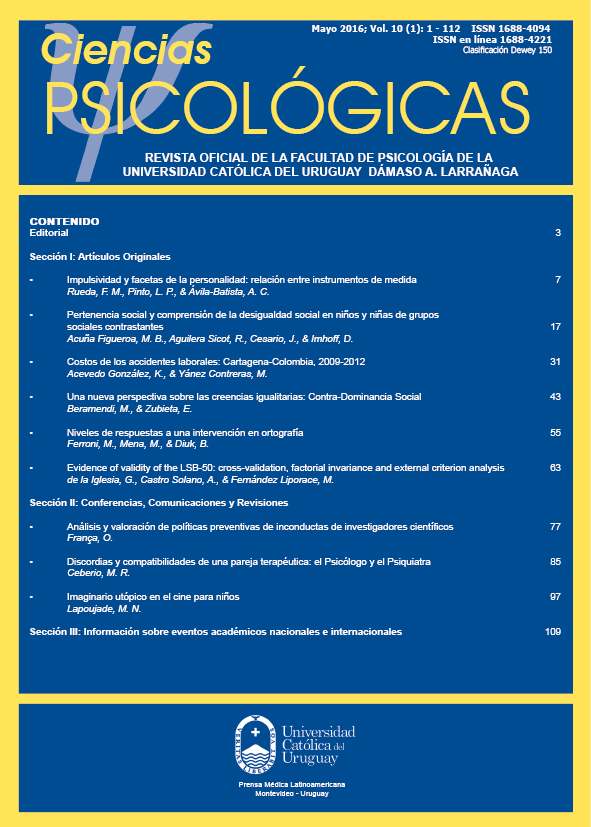DIFFERENCES IN RESPONSE TO A SPELLING PROGRAM
DOI:
https://doi.org/10.22235/cp.v10i2.1153Keywords:
spelling, orthographic representations, sub lexical unitsAbstract
The study aimed at comparing the response of 3rd. grade children to an intervention designed to promote the acquisition of orthographic representations of words children knew but could not spell. These training words contained syllables or morphemes which were orthographically complex, that is, which have two or more accepted spellings in Spanish. After the intervention, children were asked to spell the trained as well as pseudowords not presented during the intervention but which included syllables or morphemes present in the trained words, so as to explore children´s ability to acquire and transfer sub-lexical knowledge. Children´s response to intervention was calculated as the difference between their performance in spelling the trained words in the pre- and post-tests. High and low responders were compared in the spelling of the pseudowords. Results showed that the children from the high-response group performed significantly better than low-responders in the spelling of pseudowords.Downloads
References
Borzone, A. M., & Signorini, A. (2002). El aprendizaje inicial de la lectura. Incidencia de las habilidades fonológicas de la estructura de la lengua, de la consistencia de la ortografía y del método de enseñanza. Lingüística en el aula, 5, 29-48.
Burani, C., Marcolini, S., De Luca, M., & Zoccolotti, P. (2008). Morpheme-based reading aloud: Evidence from dyslexic and skilled Italian readers. Cognition, 108, 243-262. doi:10.1016/j.cognition.2007.12.010.
Cassar, M., & Treiman, R. (1997). The beginnings of orthographic knowledge: Children’s knowledge of double letters in words. Journal of Educational Psychology, 89, 631–644. doi: http://dx.doi.org/10.1037/0022-0663.89.4.631
Castles, A., & Nation, K. (2008). Learning to be a good orthographic reader. Journal of Research in Reading, 31, 1-7. doi: 10.1111/j.1467-9817.2007.00367.x
Cuadro, A., & Berná, J. (2015). Inicio de la alfabetización, habilidades prelectoras y contexto alfabetizador familiar en una muestra de niños uruguayos. Ciencias Psicológicas, 9(1), 7-14.
Dehaene, S. (2009). Reading in the brain. The science and evolution of a human invention. New York: Penguin Viking.
Dehaene, S., Cohen, C., Sigman, M., & Vinckier, F. (2005). The neural code for written words: a proposal. Trends in Cognitive Sciences, 7(9), 335-341. doi:10.1016/j.tics.2005.05.004
Diuk, B., & Borzone, A. M. (2006). Las estrategias tempranas de escritura de palabras. Análisis del patrón de aprendizaje en niños de diferente sector social de procedencia. Revista Irice, 19, 19-37.
Escobar, J. P, Tenorio, M., Ceric, F., & Rosas, R. (2014). Impacto de la calidad educativa sobre el desempeño en pruebas de inteligencia de niños con dificultades lectoras. Ciencias Psicológicas, 8(1), 17- 29
Ferroni, M. (2012). La adquisición de conocimiento ortográfico en español (Tesis doctoral, Facultad de Psicología de Universidad Nacional de La Plata). Obtenido de http://sedici.unlp.edu.ar/handle/10915/31463/discover
Gómez-Gómez, M. Danglot-Banck, C., & Vega-Franco, L. (2003). Sinopsis de pruebas estadísticas no paramétricas. Cuándo usarlas. Revista Mexicana de Pediatría, 70(2). 91-99.
Jaichenco, V., & Wilson, M. (2013). El rol de la morfología en el proceso de aprendizaje de la lectura en español. Interdisciplinaria, 30(1), 85-99.
Kairaluoma, L., Ahonen, T., Aro, M., & Holopainen, L. (2007). Boosting Reading Fluency: An intervention case study a subword level. Scandinavian Journal of Educational Research, 51, 253-274. doi: 10.1080/00313830701356117
Pacton, S., Fayol, M., & Perruchet, P. (2005). Children’s implicit learning of graphotactic and morphological regularities. Child Development, 76, 324-329. doi: 10.1111/j.1467-8624.2005.00848_a.x
Pacton, S., Perruchet, P., Fayol, M., & Cleeremans, A. (2001). Implicit learning out of the lab: The case of orthographic regularities. Journal of Experimental Psychology, 130, 401-426. doi: http://dx.doi.org/10.1037/0096-3445.130.3.401
Perfetti, C. A. (1992). The representation problem in reading acquisition. En P. B. Gough, L. C. Ehri, & R. Treiman (Eds.), Reading acquisition (pp. 145-174). Hillsdale, NJ: Lawrence Erlbaum.
Perfetti, C. A. (2007). Reading ability: lexical quality to comprehension. Scientific Studies of Reading, 11, 357-383. doi: 10.1080/10888430701530730
Sánchez Abchi, V., Borzone A. M., & Diuk, B. (2007). La escritura de textos en niños pequeños: relación entre la transcripción y la composición. Universitas Psicológica, 6, 559-570.
Shahar-Yames, D. & Share, D. L. (2008). Spelling as a self-teaching mechanism in orthographic learning. Journal of Research in Reading, 31, 22-39. doi: 10.1111/j.1467-9817.2007.00359.x
Share, D. L. (2004). Orthographic learning at a glance: On the time course and developmental onset of self-teaching. Journal of Experimental Child Psychology, 87, 267-289. doi:10.1016/j.jecp.2004.01.001
Share, D. L. (2008). Orthographic learning, phonology and the self-teaching hypothesis. Advances in Child Development and Behavior, 36, 31-82. doi: http://dx.doi.org/10.1016/S0065-2407(08)00002-5
Share, D. L. (2011). On the role of phonology in reading acquisition: The self teaching hypothesis. En S. A. Brady, D. Braze, & C. A. Fowler (Eds.), Explaining individual differences in reading: Theory and evidence, (pp. 45-68). New York, NY: Psychology Press.
Stanovich, K. E. (1982). Individual Differences in the cognitive processes of reading: I. Word Decoding. Journal of Learning Disabilities, 15, 485-493. oi:10.1177/002221948201500809
Tressoldi, P., Vio, C., & Iozzino, R. (2007). Efficacy of an intervention to improve fluency in children with developmental dyslexia in a regular orthography. Journal of Reading Disabilities, 40(3), 203–209. doi: 10.1177/00222194070400030201


















